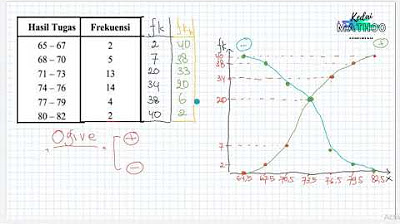How Do I Read and Interpret Tables? | KS2 Maths Concept for Kids
Summary
TLDRThis educational video focuses on teaching viewers how to read and interpret data from tables. It explains key concepts such as rows, columns, and how to use them to answer specific questions based on a table's data. Through various examples, such as determining the number of packed lunches on a particular day or calculating temperature differences across cities, viewers learn to apply simple mathematical operations like subtraction and addition. The video also includes a challenge to evaluate statements based on table data, reinforcing the importance of clear reasoning in data interpretation.
Takeaways
- 😀 A table is a chart used to organize and record information, often called data.
- 😀 Rows are horizontal lines of data, while columns are vertical lines of data in a table.
- 😀 To interpret data, you can use the row and column headings to locate specific information.
- 😀 When asked to compare numbers, subtraction can help calculate the difference between values.
- 😀 The term 'fewest' refers to the smallest number, which is key when identifying the lowest value in a column.
- 😀 To calculate a total, add up all the numbers in a specific column or row.
- 😀 The 'average temperature' question requires looking at specific rows for each city during a given month.
- 😀 Sorting data from highest to lowest can help answer questions about rankings (e.g., third-highest temperature).
- 😀 Comparing temperatures across cities helps understand relative differences, such as how much colder one city is than another.
- 😀 Some statements based on table data can be verified by counting or calculating, ensuring accuracy in conclusions.
- 😀 This video encourages practicing data interpretation, with more resources available for further learning.
Q & A
What is the main purpose of this video?
-The main purpose of the video is to help viewers understand how to read and interpret information from a table.
What are the terms used to describe the horizontal and vertical lines of data in a table?
-The horizontal lines of data are called rows, and the vertical lines of data are called columns.
How can we determine the number of children with packed lunches on Thursday from the table?
-To find the number of children with packed lunches on Thursday, we locate the 'Packed Lunch' column and the 'Thursday' row. The number in the intersecting box is 17.
What method is used to find out which day had the fewest school dinners ordered?
-To determine the day with the fewest school dinners, we look at the entire 'School Dinners' column and identify the smallest number.
How do you calculate the difference between the number of children who had packed lunches on Monday and Wednesday?
-To calculate the difference, we subtract the number of children with packed lunches on Wednesday (13) from Monday (18), resulting in a difference of 5.
How do you calculate the total number of school dinners ordered by class 6 during the week?
-To calculate the total number of school dinners, we add up all the numbers in the 'School Dinners' column.
What is the average temperature in Copenhagen in July as provided in the table?
-The average temperature in Copenhagen in July is 17 degrees Celsius.
How can we determine which city had the third highest average temperature in October?
-To find the third highest average temperature in October, we arrange the temperatures for October in order and identify the city with the third-highest value, which is Dublin.
How do you find the temperature difference between Dublin and Athens in April?
-To find the temperature difference, we subtract the average temperature in Dublin (9°C) from the average temperature in Athens (16°C), giving a difference of 7°C.
How do you calculate the temperature difference between Barcelona's coldest and hottest months?
-To calculate this difference, we subtract the lowest average temperature in Barcelona (9°C in January) from the highest (24°C in July), giving a difference of 15°C.
Outlines

This section is available to paid users only. Please upgrade to access this part.
Upgrade NowMindmap

This section is available to paid users only. Please upgrade to access this part.
Upgrade NowKeywords

This section is available to paid users only. Please upgrade to access this part.
Upgrade NowHighlights

This section is available to paid users only. Please upgrade to access this part.
Upgrade NowTranscripts

This section is available to paid users only. Please upgrade to access this part.
Upgrade NowBrowse More Related Video

Telecurso 2000 - Metrologia - 05 Leitura no Sistema Métrico

Data - Materi Matematika Kelas 5 Kurikulum Merdeka

Video Pembelajaran Matematika Kelas 7 SMP ( Pengolahan Data )

Averages from Frequency Tables (including Estimating the Mean)

Statistika Deskriptif (Bag 1): Cara Membuat dan Membaca OGIVE

Investigasi Statistika Hal 185-193 Bab 6 DATA DAN DIAGRAM kelas 7 SMP Kurikulum Merdeka
5.0 / 5 (0 votes)